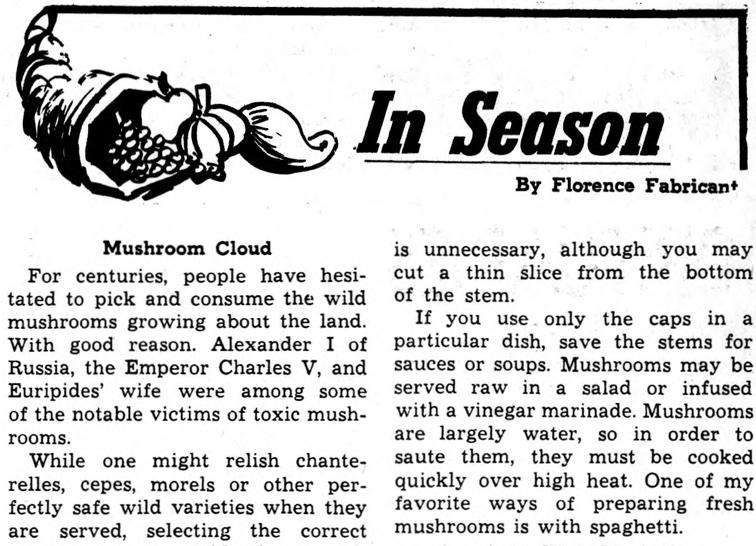For centuries, people have hesitated to pick and consume the wild mushrooms growing about the land. With good reason. Alexander I of Russia, the Emperor Charles V, and Euripides' wife were among some of the notable victims of toxic mushrooms.
While one might relish chanterelles, cepes, morels or other perfectly safe wild varieties when they are served, selecting the correct specimens in the field takes experience. An authoritative guidebook, or guide, should accompany the forager. (I have heard that the little orange mushrooms which grow in the cranberry bogs at Napeague are excellent for eating but I do not know anyone who has tried them.)
People who shudder at the very notion of eating wild mushrooms may be exposing themselves to a new form of mushroom danger, with which the FDA has (fortunately) managed to keep pace. The mushrooms packed neatly in shining cans, mechanically sliced and cooked may be just as toxic as the toadstool.
The threat comes from botulism, which can develop during processing. So far all the suspect batches (from numerous canners under numerous labels) have been seized.
As a result, it seems that the price of fresh mushrooms has dropped, although one might reasonably expect that the demand for them would be greater. (Mushrooms are usually cheaper in fall and winter.) You should be able to buy a pound of fresh mushrooms for less than a dollar; perhaps much less.
Why anyone would buy canned mushrooms in the first place has always been a mystery to me. They probably don’t cost less (a pound of fresh mushrooms goes very far). They have no taste and their texture is like tender rubber bands. Besides, any dish REQUIRING mushrooms cannot be successfully prepared using the canned variety.
European or Chinese dried mushrooms are another matter entirely. Reconstituted by soaking in warm water, these are delicious, often exotic varieties commercially unobtainable in this, the land of the white button "agericus" mushroom.
Firm and White
When buying mushrooms, select firm, white, tightly capped ones. While slightly shriveled or brownish mushrooms may be used in cooking, they should be sold at a reduced price. Fresh mushrooms will keep up to about a week in the refrigerator.
Make sure they are dry, loosely packed and uncovered. (As with most produce, they should not be rinsed until ready to use.) Peeling is unnecessary, although you may cut a thin slice from the bottom of the stem.
If you use only the caps in a particular dish, save the stems for sauces or soups. Mushrooms may be served raw in a salad or infused with a vinegar marinade. Mushrooms are largely water, so in order to sauté them, they must be cooked quickly over high heat. One of my favorite ways of preparing fresh mushrooms is with spaghetti.
Spaghetti With Mushrooms
1 lb. spaghetti
1 lb. fresh mushrooms, sliced
6 Tbsp. butter
3 Tbsp. olive oil
2 cloves garlic, minced
1/2 tsp. salt (or to taste)
1/2 tsp. freshly ground black pepper (or to taste)
3 Tbsp. minced parsley
Freshly grated parmesan cheese
Optional: half cup heavy cream, half cup minced prosciutto)
Start cooking spaghetti according to package directions. While spaghetti is cooking, sauté mushrooms in four tablespoons of the butter and two tablespoons of the olive oil until lightly browned. Add garlic and cook for another minute or two.
Season (to taste) with salt and pepper. When spaghetti is finished, drain it well and toss it with remaining butter and oil. Season with salt and pepper. Place spaghetti in a large serving bowl.
Briefly reheat mushrooms and pour over spaghetti. Sprinkle parsley on top and serve, with parmesan cheese passed separately. (If desired, heavy cream and prosciutto may be mixed with spaghetti before mushrooms are added.) Serves four to six.





